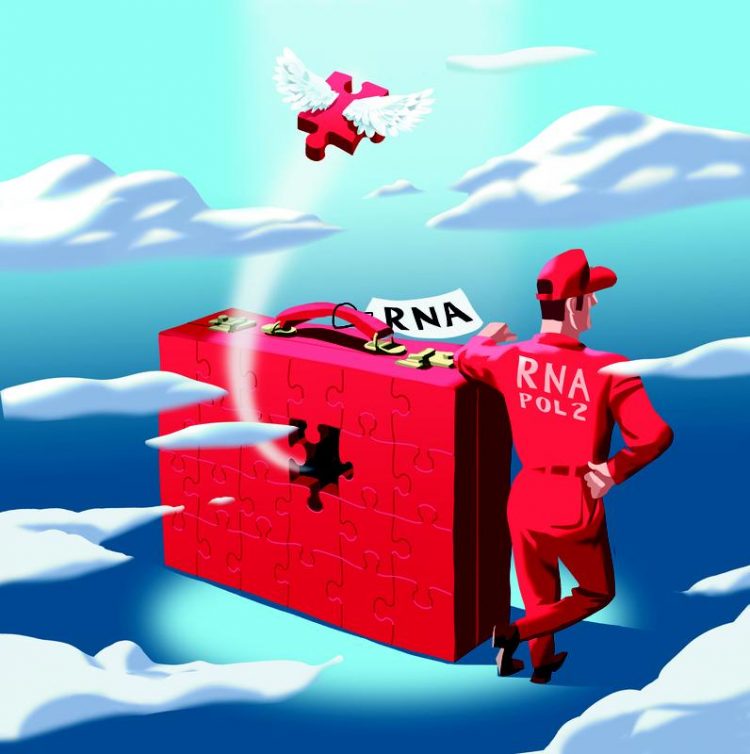Store and Supply – How the Brain Saves Time

A storage of RNA molecules allows the brain to rapidly react to neuronal stimuli. Image: University of Basel, Biozentrum
Our brain is not only the most complex organ of the human body, it is also the most flexible. But how do neurons in the brain adapt their function in response to stimuli within a very short time frame?
The research group of Prof. Peter Scheiffele at the Biozentrum, University of Basel, has demonstrated that neurons store a reserve stock of RNA molecules, copies of the DNA, in the cell’s nucleus. These RNA molecules form the blueprint for new proteins. After a neuronal stimulus, the stored RNA molecules are mobilized in order to adjust the function of the neuron. The process of RNA synthesis (DNA copying) is very slow, especially for large genes. Thus, this newly uncovered mechanism for mobilization of stored RNAs saves time and provides new insights regarding the fast adaptation of the brain during learning processes.
Storage for RNA molecules
The RNA blueprint for proteins is produced by a sophisticated copying process: First, a basic RNA copy of the DNA is generated. From this copy, individual sections, so-called introns, are subsequently cut out to provide a finalized blueprint for the production of a specific protein. This process is called RNA splicing.
So far, it was assumed, that neuronal stimuli trigger the complete process for the production of new RNA molecules. However, the team of Peter Scheiffele now discovered that neurons in the brain pre-manufacture certain immature RNA copies which are only partially spliced. These RNA molecules still contain some introns and are stored in the cell nucleus. Signals induced by neuronal stimulation trigger the splicing completion of the immature RNA molecules.
“The copying process of the DNA, the so-called transcription, is already finalized in advance by the neurons. Hence, mature RNA molecules can be produced within minutes,” explains Oriane Mauger, the first author.
Prepared copies save time
For large genes, the production of the initial version of the RNAs itself takes dozens of hours. “The fact that the RNA molecules are already available in an immature form and only need to be completed, shortens the whole process to a few minutes”, says Mauger. “Since the transcription is very time-consuming, the storage of RNA means a significant time saving. This enables neurons to quickly adapt their function.”
“This study reveals a completely new regulatory mechanism for the brain”, declares Scheiffele. “The results provide us with a further explanation of how neurons steer rapid plasticity processes.”
Original source
Oriane Mauger, Frédéric Lemoine, and Peter Scheiffele
Targeted Intron Retention and Excision for Rapid Gene Regulation in Response to Neuronal Activity
Neuron (2016), doi: 10.1016/j.neuron.2016.11.032
Further information
Prof. Dr. Peter Scheiffele, University of Basel, Biozentrum, Tel. +41 61 207 21 94, Email: peter.scheiffele@unibas.ch
Heike Sacher, University of Basel, Biozentrum, Communications, Tel. +41 61 207 14 49, Email: heike.sacher@unibas.ch
Media Contact
All latest news from the category: Life Sciences and Chemistry
Articles and reports from the Life Sciences and chemistry area deal with applied and basic research into modern biology, chemistry and human medicine.
Valuable information can be found on a range of life sciences fields including bacteriology, biochemistry, bionics, bioinformatics, biophysics, biotechnology, genetics, geobotany, human biology, marine biology, microbiology, molecular biology, cellular biology, zoology, bioinorganic chemistry, microchemistry and environmental chemistry.
Newest articles

Zap Energy achieves 37-million-degree temperatures in a compact device
New publication reports record electron temperatures for a small-scale, sheared-flow-stabilized Z-pinch fusion device. In the nine decades since humans first produced fusion reactions, only a few fusion technologies have demonstrated…

Innovative microscopy demystifies metabolism of Alzheimer’s
Researchers at UC San Diego have deployed state-of-the art imaging techniques to discover the metabolism driving Alzheimer’s disease; results suggest new treatment strategies. Alzheimer’s disease causes significant problems with memory,…

A cause of immunodeficiency identified
After stroke and heart attack: Every year, between 250,000 and 300,000 people in Germany suffer from a stroke or heart attack. These patients suffer immune disturbances and are very frequently…





















